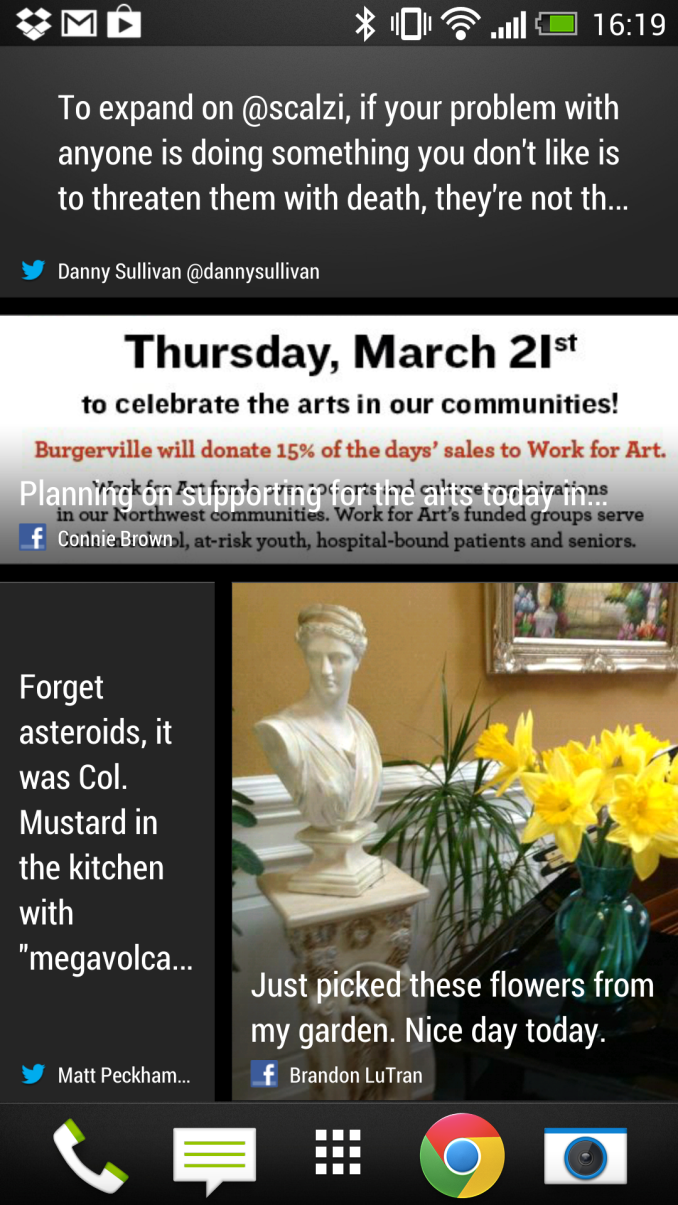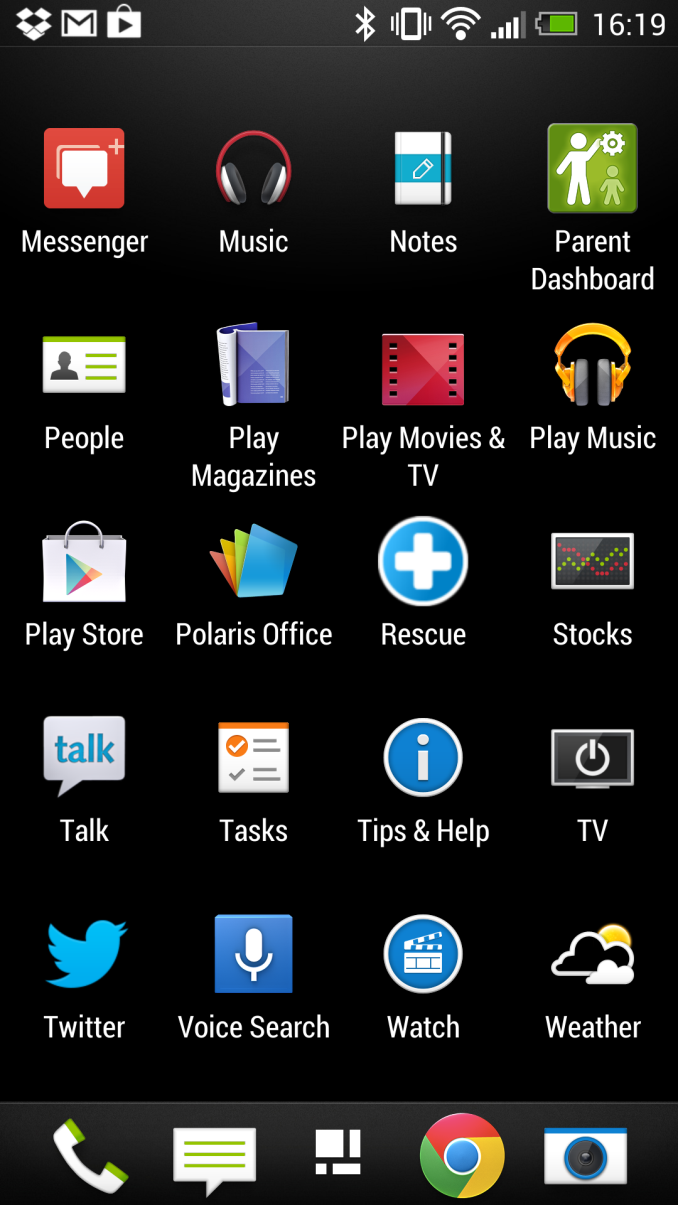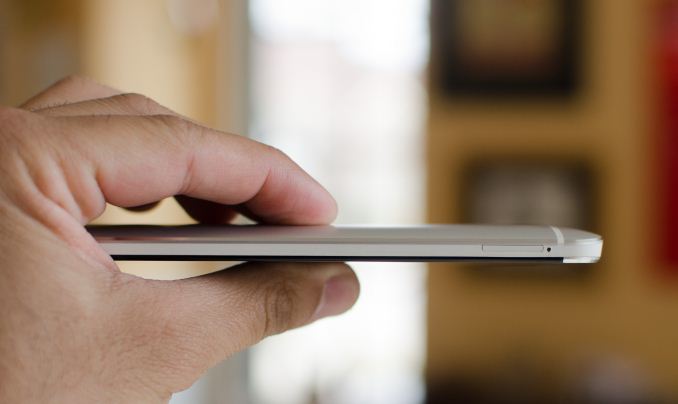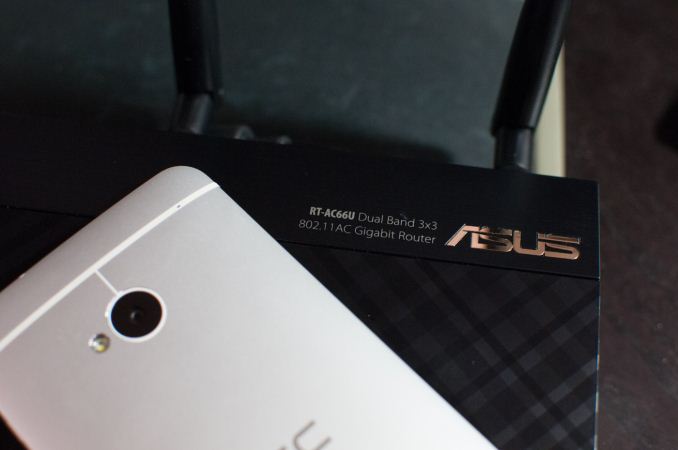The HTC One: A Remarkable Device, Anand’s mini Review
by Anand Lal Shimpi on March 21, 2013 4:49 PM EST- Posted in
- Smartphones
- HTC
- Mobile
- HTC One
Android/Sense
The One ships with Sense 5.0, and I have to say that the latest version of Sense is really the first custom Android skin that I don’t mind. I’m not sold on Blinkfeed, the default homescreen that allows you to aggregate content from multiple web sources as well as Twitter and Facebook, but thankfully you can easily change that default to something more traditionally Android.
With Sense 5.0 HTC dramatically reduced the presence of widgets on the default home screen. Other than the Blinkfeed screen, there’s only a single home screen by default and the only widget on that screen is a Google search box. You can obviously add all of the widgets you want, but this is a noticeable departure from HTC’s strategy in the past. To be honest, it’s a lot cleaner.
Sense 5.0 isn’t intrusive, and the work HTC has done in the gallery app sort of make the customizations worth it (more on this later). Even the default pre-load of apps is very sensible.
Thanks to the underlying use of Android 4.1.2 combined with the fast Snapdragon 600 SoC, UI frame rate is incredibly smooth. Some interactions are still not perfect (e.g. zooming in Google Maps) but the overall experience is very polished and very fast.
Performance & Battery Life
The One is the first Snapdragon 600 based smartphone that I’ve used regularly. For those who aren’t familiar with Qualcomm’s latest branding change, Snapdragon 600 refers to a quad-core Krait 300 based SoC with Adreno 320 graphics (APQ8064T). The SoC still uses the same 28nm LP process as the previous quad-core flagship (APQ8064), but clocks are a bit higher (1.7GHz in the One, 1.9GHz in the Galaxy S 4).
GPU clocks appear unchanged, which is contrary to what I was told at the launch of Krait 300 but it’s entirely possible that we’ll see implementation with higher GPU clocks.
Performance, as I mentioned before, is very good. Even the speed of the NAND HTC used in the device is among the best I’ve seen in Android devices. We’re still not yet at the point where I believe smartphone SoC performance is good enough, but at least we won’t see a huge jump in SoC performance (at similar power) until the move to 20nm in mid to late 2014.
The impact of all of this on battery life, as always, depends on your usage model. I’ve been using the international One on AT&T, and 3G battery life is comparable to the iPhone 5 on the same network (non-LTE) at identical brightness levels. I have yet to see what the difference will be like with LTE enabled.
Obviously with four cores and a larger, higher resolution display, the One definitely has the ability to draw more power than the iPhone 5. Keep the cores more active and/or drive the display at very high brightness levels and you’ll see worse battery life. For the past couple of years I’ve been talking about the increase in dynamic range when it comes to smartphone battery life, the One is no different in this regard. Brian will have a full rundown of battery life data on the One in his review.
Other Frills: Of Big Screens and Usability
For me, the iPhone 5’s display is a little too small, and the One is probably a little too big. I think I agree with Brian here in that the ideal display size is somewhere around 4.3”. That being said, I find both devices (the 5 and the One) to be comfortably usable. The 5 is better for one handed use, while the One is better for actually consuming web content. In pocket, the One is thin enough to not be a problem.
Although it’s probably a bit overkill, I am pleased with the move to 1080p across all of the high end Android smartphones. The One’s display looks excellent and lacks the oversaturated colors of the alternative AMOLED displays.
The One also features stereo speakers that get impressively loud (louder than any other smartphone I’ve used, by a considerable margin). I keep my phone on silent all the time but when showing others highlights reels, the One’s loud stereo speakers definitely come in handy.
The final element of the One that I’m really happy about is the integration of 802.11ac support. The One is good for WiFi speeds of up to 275Mbps (that’s actually tested, not theoretical).














434 Comments
View All Comments
Pylon757 - Thursday, March 21, 2013 - link
Um, Apple and their sapphire lenses?uhuznaa - Friday, March 22, 2013 - link
Sapphire glass cover over the lenses, not the lenses itself.CeriseCogburn - Friday, March 22, 2013 - link
glass covers front and back of the iphone shatterbricks...LOL
crack !
jayseeks - Friday, March 22, 2013 - link
Wow, you're an invalid.tipoo - Friday, March 22, 2013 - link
Correct, but if I remember right wasn't there a Sony phone with all glass elements?JDG1980 - Thursday, March 21, 2013 - link
For all the concerns about smartphone camera quality, why haven't there been any phones that let you shoot images in RAW format? For anyone who wants to do serious post-processing, JPEGs simply aren't good enough. You need the full dynamic range captured by the sensor.nerd1 - Thursday, March 21, 2013 - link
Phone camera sensors don't have ANY dynamic range to speak of.That's why they are trying heavily the HDR stuff.
evonitzer - Friday, March 22, 2013 - link
In an academic sense, it would be good to see the RAW results from phone cameras, but I have a feeling the results would be pretty hideous. The first manufacturer to release RAW will be praised by enthusiasts, but will be mobbed by the fake-enthusiasts for the amounts of noise coming off their sensors. Which will be copious.danbob999 - Thursday, March 21, 2013 - link
I find your conclusion pretty ironic. As if "enthusiasts" should prefer a phone that, according to you, looks better but the mass would prefer a phone with factual benefits (such as larger display, smaller size and larger battery).I would have said the opposite.
"Mainstream" customers are those who buy phones that sucks only because they look good.
CeriseCogburn - Friday, March 22, 2013 - link
That's the applefanboy argument - which includes "the feeeeeeeeeel".If they actually use a phone they won't notice the feeeeeel after a week if that long, more likely days.
At that point the harsh appletard edges cut into your hands and finger tendons before the shatterbrick breaks when dropped.